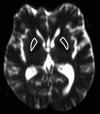Hyperintense putaminal rim at 1.5 T: prevalence in normal subjects and distinguishing features from multiple system atrophy
- PMID: 22708511
- PMCID: PMC3460737
- DOI: 10.1186/1471-2377-12-39
Hyperintense putaminal rim at 1.5 T: prevalence in normal subjects and distinguishing features from multiple system atrophy
Abstract
Background: Hyperintense putaminal rim (HPR) is an important magnetic resonance imaging (MRI) sign for multiple system atrophy (MSA). Recent studies have suggested that it can also be observed in normal subjects at 3 T. Whether it can be observed in normal subjects at 1.5 T is not known. This study aimed to determine whether HPR could be observed in normal subjects at 1.5 T; and if so, to establish its prevalence, the MRI characteristics, and the features which distinguish from HPR in MSA patients.
Methods: Axial T2-weighted images of 130 normal subjects were evaluated for the prevalence of HPR, its age and gender distribution, laterality, maximum dimension, association with hypointensity of nearby putamen, and presence of discontinuity. To distinguish from that observed in MSA, axial T2-weighted images of 6 MSA patients with predominant parkinsonism (MSA-P) and 15 MSA patients with predominant cerebellar symptoms (MSA-C) were also evaluated. The characteristics of HPR were compared between these patients and age-matched normal subjects. The mean diffusivity (MD) values of putamen were also compared. Fisher's exact test, t-test, and one way analysis of variance were used to determine significance at corrected p < 0.05.
Results: HPR was observed in 38.5% of normal subjects. Age and gender predilection and laterality were not observed. In most cases, it occupied the full length or anterior half of the lateral margin of putamen, and was continuous throughout its length. Maximum transverse dimension was 2 mm. There was no association with hypointensity of nearby putamen. However, in MSA-P, HPR was located predominantly at the posterolateral aspect of putamen, and associated with putaminal atrophy. Discontinuity of HPR was more frequently observed in MSA-P. On visual analysis, the characteristics of HPR were similar between MSA-C patients and normal subjects. Patients with MSA of either type had significantly higher MD values of putamen than normal subjects.
Conclusions: HPR can be observed in 38.5% of normal subjects at 1.5 T. Thin linear hyperintensity without discontinuity, occupying the full length or anterior half of the lateral margin of the putamen, is suggestive of "normal." In doubtful cases, measurement of the MD values of nearby putamen may be valuable.
Figures





Similar articles
-
The putaminal abnormalities on 3.0T magnetic resonance imaging: can they separate parkinsonism-predominant multiple system atrophy from Parkinson's disease?Acta Radiol. 2015 Mar;56(3):322-8. doi: 10.1177/0284185114524090. Epub 2014 Mar 11. Acta Radiol. 2015. PMID: 24619850
-
Putaminal hyperintensity on T1-weighted MR imaging in patients with the Parkinson variant of multiple system atrophy.AJNR Am J Neuroradiol. 2009 Apr;30(4):689-92. doi: 10.3174/ajnr.A1443. Epub 2009 Jan 15. AJNR Am J Neuroradiol. 2009. PMID: 19147717 Free PMC article.
-
Usefulness of 3D-PRESTO imaging in evaluating putaminal abnormality in parkinsonian variant of multiple system atrophy.Neuroradiology. 2010 Sep;52(9):809-14. doi: 10.1007/s00234-009-0621-9. Epub 2009 Nov 6. Neuroradiology. 2010. PMID: 19894040
-
[Multiple system atrophy].Psychol Neuropsychiatr Vieil. 2010 Sep;8(3):179-91. doi: 10.1684/pnv.2010.0212. Psychol Neuropsychiatr Vieil. 2010. PMID: 20739256 Review. French.
-
Progression and prognosis in multiple system atrophy: an analysis of 230 Japanese patients.Brain. 2002 May;125(Pt 5):1070-83. doi: 10.1093/brain/awf117. Brain. 2002. PMID: 11960896 Review.
Cited by
-
Dilemma of multiple system atrophy and spinocerebellar ataxias.J Neurol. 2018 Dec;265(12):2764-2772. doi: 10.1007/s00415-018-8876-x. Epub 2018 Apr 26. J Neurol. 2018. PMID: 29700645 Review.
-
The Relevance of Iron in the Pathogenesis of Multiple System Atrophy: A Viewpoint.J Alzheimers Dis. 2018;61(4):1253-1273. doi: 10.3233/JAD-170601. J Alzheimers Dis. 2018. PMID: 29376857 Free PMC article. Review.
-
Role of Magnetic Resonance Imaging in the Diagnosis of Multiple System Atrophy.Mov Disord Clin Pract. 2016 Jul 28;4(1):12-20. doi: 10.1002/mdc3.12404. eCollection 2017 Jan-Feb. Mov Disord Clin Pract. 2016. PMID: 30363358 Free PMC article. Review.
-
Update on the Clinical, Radiographic, and Neurobehavioral Manifestations in FXTAS and FMR1 Premutation Carriers.Cerebellum. 2016 Oct;15(5):578-86. doi: 10.1007/s12311-016-0799-4. Cerebellum. 2016. PMID: 27287737 Free PMC article. Review.
-
Emerging differences between Huntington's disease-like 2 and Huntington's disease: A comparison using MRI brain volumetry.Neuroimage Clin. 2019;21:101666. doi: 10.1016/j.nicl.2019.101666. Epub 2019 Jan 7. Neuroimage Clin. 2019. PMID: 30682531 Free PMC article.
References
-
- Savoiardo M, Strada L, Girotti F, Zimmerman RA, Grisoli M, Testa D, Petrillo R. Olivopontocerebellar atrophy: MR diagnosis and relationship to multisystem atrophy. Radiology. 1990;174(3):693–696. - PubMed
Publication types
MeSH terms
LinkOut - more resources
Full Text Sources
Medical

